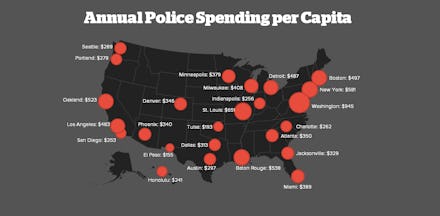These Are the Alarming Charts Police Don’t Want You to See After Ferguson

Tear gas. Armored transports. Military-grade weaponry. These are the images burned into our minds in the wake of the chaos in Ferguson earlier this month.
Just one of the many disturbing revelations coming out of Ferguson is the militarization of local police departments across the U.S.
This statistic captures the trend: Despite a global recession that crippled city finances, the total spending on police per American increased by 28% between 2001 and 2010, according to figures from the Bureau of Justice Statistics. And that's the increase after taking inflation into account.
The story gets more interesting when examining police spending at the city level. The map below shows how much it costs, per person, to support police departments in various cities.
Are people in cities that spend more on police safer? No. This is clear from the interactive chart below, which ranks cities by their violent crime and property crime rates. Violent crimes are defined as murder, non-negligent manslaughter, forcible rape, robbery, or aggravated assault. Property crimes are burglary, larceny, or motor vehicle theft.
Detroit and St. Louis top the violent crime ranking, and both spend more on policing per person than most major cities.
Data from 2010. Crime rates are the number of incidences per 100,000 residents. Violent crime includes murder, non-negligent manslaughter, forcible rape, robbery, and aggravated assault. Property crime includes burglary, larceny, and motor vehicle theft.
Source: Uniform Crime Reporting Statistics
Can we learn anything from relating police spending to city crime? No — and this chart proves it:
Crime rates are all over the place, and show no correlation to police spending. Take Baton Rouge and Tulsa, which have about the same violent crime rate, but Baton Rouge spends $538 per resident on police and Tulsa spends $193.
If police spending reliably reduced crime, you would see a downward sloping trend from left to right.
What about for property crime rates? Same story as violent crime — lots of variation between spending and outcomes. Randomness:
The takeaway: Throwing money at policing doesn't necessarily make our communities safer.
The recent images of armored transport on suburban streets show that much of America wrongly approaches safety at home as a peacekeeping problem. More danger on the streets must mean we need better-equipped police to impose stricter order.
Our communities aren't war zones though.
The random distribution of crime rates around the country signals that crime has complex causes. Yes, the police serve a critical function in safeguarding our communities, but only up to a point. Crime is a symptom of more complex community problems — like lack of educational and economic opportunity — rather than a cause.
Every piece of body armor means fewer dollars going to the deeper problems in our communities. Fewer school textbooks, more pot holes, reduced hours at the community center. That's the real price of "safety."